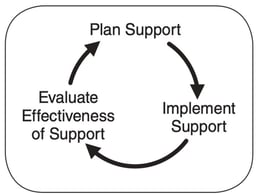Interpreting Acadience Math Data
There are four frames of reference in providing meaning for Acadience Math scores: (a) criterion-referenced benchmark goals and cut points for risk; (b) individually referenced interpretations; (c) local norm-referenced interpretations; and (d) system-wide or national, norm-referenced interpretations.
While all frames of reference provide valuable information about a student, the authors of Acadience Math generally regard the criterion-referenced information as most important, followed by the individually referenced information, and then the local norm-referenced information. These four frames of reference can be used to interpret results on individual scores and on the Math Composite Score (MCS). The MCS is a combination of multiple Acadience Math scores and provides the best overall estimate of the student’s math proficiency.
Criterion-Referenced Interpretations: Understanding Benchmark Goals and Cut Points for Risk
Acadience Math benchmark goals are empirically derived, criterion-referenced target scores that represent adequate math progress. A benchmark goal indicates a level of skill at which the student is likely to achieve the next Acadience Math benchmark goal or math outcome. Benchmark goals for Acadience Math are based on research that examines the predictive validity of a score on a measure at a particular point in time, compared to later Acadience Math measures and external outcome assessments. If a student achieves a benchmark goal, then the odds are in favor of that student achieving later math outcomes if the student receives research-based instruction from a core classroom curriculum.
The cut points for risk indicate a level of skill below which the student is unlikely to achieve subsequent math goals without receiving additional, targeted instructional support. Students with scores below the cut point for risk are identified as likely to need intensive support. Intensive support refers to interventions that incorporate something more or something different from the core curriculum or supplemental support. Intensive support might entail:
• delivering instruction in a smaller group;
• providing more instructional time or more practice;
• presenting smaller skill steps in the instructional hierarchy;
• providing more explicit modeling and instruction; and/or
• providing greater scaffolding.
Because students needing intensive support are likely to have individual and sometimes unique needs, their progress is monitored frequently and their intervention is modified dynamically to ensure adequate progress.
Plan, Implement, and Evaluate Support Cycle from the Outcomes-Driven Model

Students are likely to need strategic support when their scores are between the benchmark goal and the cut point for risk. In this range, a student’s future performance is harder to predict. Strategic instructional support is carefully targeted additional support in the skill areas where the student is having difficulty. These students should be monitored regularly to ensure they are making adequate progress, and should receive increased or modified support, if necessary, to achieve subsequent math goals.
To gain a better understanding of what Acadience Math results mean in a local context, districts and schools can examine the linkages between the Acadience Math benchmark goals and cut points for risk and their own outcome assessments, such as state-level criterion-referenced tests. By comparing Acadience Math measures to an outcomes assessment and by calculating conditional probabilities (e.g., “80% of students at benchmark on Acadience Math Computation at the end of third grade met the Proficient level on the state criterion-referenced test”), schools can determine how the Acadience Math benchmark goals compare to their own external criteria.
A score at or above the benchmark goal indicates that the odds are in the student’s favor of achieving the next goal, but it is not a guarantee. For example, if students at or above the benchmark goal have an 85% chance of meeting the next goal, that means that 15% of students in the benchmark range may not achieve that goal. Some students who achieve scores at or above the benchmark goal may still need supplemental support to achieve the next goal. It is important to attend to other indicators of risk when planning support for students, such as attendance, behavior, motivation, vocabulary and language skills, reading skills, and other related skill areas.

